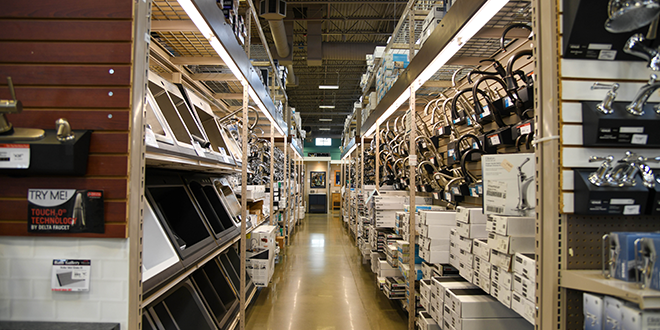With an Excel file, a few well thought out formulas and a desire product selection at the basic level, Cody Miller created his own program for determining the profitability of each department—down to a 4-foot section in each—in his operation’s 305,000-square-foot location.
 Miller, merchandise manager for the lumber and building materials division of Hartville Hardware in Hartville, Ohio, graduated from the North American Hardware and Paint Association’s Retail Management Certification Program. As part of the program, he completed a business improvement project—the Gross Profit Map—and implemented it at the store, which has allowed management to evaluate different departments for profitability.
Miller, merchandise manager for the lumber and building materials division of Hartville Hardware in Hartville, Ohio, graduated from the North American Hardware and Paint Association’s Retail Management Certification Program. As part of the program, he completed a business improvement project—the Gross Profit Map—and implemented it at the store, which has allowed management to evaluate different departments for profitability.
“We wanted a different way to analyze our inventory and the space that inventory was taking up in our store,” Miller says. “At the time I was taking the course, our new store had been open for six years, and during that time some departments had grown and some decreased. This resulted in certain areas not having the room to grow and other areas being left with a lot of wasted space. We found we were not using our entire store space as efficiently as we could have been.”
At its essence, the Gross Profit Map charts out each aisle and assigns sales data to those spaces. It is a layout of the store in an Excel file that displays gross profit for the last 12 months for each 4-foot section in each aisle of the store.
The Gross Profit Map provides an overhead view of the store, similar to a house blueprint, highlighting the sections that are high performing and those that are underperforming. It identifies underperforming departments and areas of the store and shares that information with purchasing managers, floor managers and upper management so they can make a plan to improve space efficiency and sales.
“By using the Gross Profit Map, we can easily identify these unprofitable areas. Then once identified, we can develop a plan to increase profitability in these areas,” Miller says. “We have a quick and unique visual on what sections are losing money and need attention, and those that are high performing that have potential for growth.”
Merchandise managers at Hartville Hardware are responsible for making all the buying decisions for their department, as well as making the decisions on product placement. The Gross Profit Map provides a way for those managers to better evaluate their areas for types of products to include and even how to place and merchandise those items.
Since Miller launched the Gross Profit Map, Hartville Hardware has bought several other stores. The map was used right away in each of those new stores to gain a quick understanding of how those retail spaces were performing, and the data gathered led to major resets in two of the stores, Miller says. In the 6 months following the reset, there was a 46% increase in sales overall with the power tools department saw 49% growth in six months and the addition of several new brands.
Miller says he and his team have created action plans based on the Gross Profit Map information. Examples of actions include condensing a section or department by discontinuing a product to make room to expand the high performing sections, moving a high performing section to a more visible or higher traffic area to increase sales, performing department resets to maximize the gross profit per foot or just visually updating a section.
Using the tool, Miller has found around 135 4-foot sections in the main store that are producing less than $500 gross profit, which is the breakeven number Miller has determined each section needs to cover all costs for that area. The average gross profit of these sections is $247.78, so assuming they can improve each section to product $500, it would add $34,302 of gross profit to the the store.
“My goal for the project was to create a long-term sustainable resource to help make our store more efficient and profitable,” Miller says. “The map has helped us become more efficient with the space and layout of our store, helping us work towards not having any sections or aisles that are losing money.”
Discover More
Hear more about Miller’s innovation at the 2023 NHPA Independents Conference held Aug. 2-3, 2023 in Dallas. During the conference, Miller will take part in a panel discussion on “Streamlining Operations Using Technology.” Learn more about their panel and the other tech topics being presented and register for the conference here.
 Hardware Retailing The Industry's Source for Insights and Information
Hardware Retailing The Industry's Source for Insights and Information








